
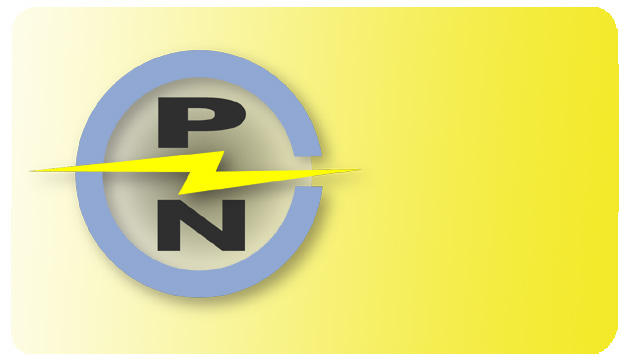
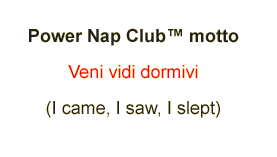
![]()
 |
 |
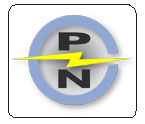 |
 |
|
Power Nap Club |
Who is Anton Anderson? |
View a Power Nap Club |
Back to School |
Want to view our videos?
Here’s what you’ll need
Software: You’ll need Real Player software on your computer to view the movies above. CLICK HERE to install RealPlayer.
Connection Speed: We’re offering you a choice of file sizes. Pick the one that works best for your type of internet connection.
S - Small, low-res video clip, quality not the best but downloads quickly. Recommended for dial-up connections.
M - Medium, decent quality; will download quickly if you have a T1 or DSL connection.
L - Large, best quality, like going to the movies, as long as you don’t mind waiting a while for the video to download. Requires a high speed connection and patience to download.
![]()
![]()
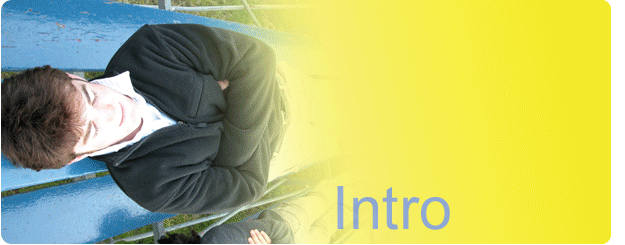
The Power Nap Club was created by high-school English teacher, Anton Anderson. The Latin motto of the Power Nap Club, Veni, Vidi, Dormivi – I came, I saw, I slept, quickly dispels the notion that this club is in any way a joke.
“You snooze, you lose” is not an expression anyone would apply to the POWER NAP CLUB™.
Anderson notes, “Teenagers today are totally oversubscribed. I’ve been teaching for 36 years; it’s clear to me that the pressures on kids today are unprecedented in the history of adolescence . . . we are expecting them to function like executives of fast-moving businesses when they are only 15 or 16 years old. They have to constantly perform in the classroom, in athletics, community service and jobs. I see too many exhausted kids.”
|
Since October 2002, Anderson’s Power Nap Club™ has generated an avalanche of media coverage. . . >READ THE REVIEWS . According to many of these editorial feature stories, Anderson is not the only teacher to express concern over his daily experience of facing weary, overscheduled teens, struggling to stay awake in class. And he’s not the only one to realize that the Power Nap Club™ is an effective antidote/coping strategy for an entire generation of stressed-out American teenagers pressured and obsessed with an unattainable vision of perfection – the best schools and most competitive colleges, the hippest clothes, a perfect body, the coolest friends . . . |
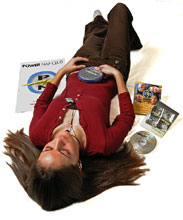 |
 |
During the Power Nap Club’s weekly meetings after school, Anderson, who studied transcendental meditation and yoga, soothes his students into a restful state of slumber with a variety of relaxation and visualization techniques, accompanied by peaceful, acoustic instrumental background music. |
|
After months of working together to research and record Anderson’s Power Nap technique, the result is the NEW Power Nap Kit™, offered exclusively through At Peace® Media. |
• Do you have questions about starting your own Power Nap Club (PNC)?
Visit Ask Anton to join our new interactive forum for teachers, educators, parents and students that will debut in September 2003 along with the release of the Power Nap Kit™.
• Read polling results from real students in Anton’s PNC in Teen Stress.
• View a PNC demonstrating their technique on local TV.
This KOMO4 News clip showcases a new PNC started by a PNK customer.
• Learn more about how lack of sleep or irregular sleep habits can undermine your health and well-being.
Visit the PowerNap/Sleep Info center
|
Power Nap Kit™ and Power Nap Club™ are trademarks of |
 |
About At Peace Media
1-800-575-7715
![]()
![]()
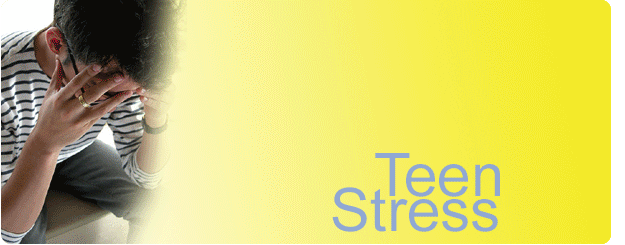 |
Welcome to the world of TEEN STRESS . . .
It’s a fact . . . teenagers today are over-scheduled, stressed out, chronically sleep-deprived and in desperate need of coping strategies and solutions. When Anton Anderson asked members of his after-school Power Nap Club (PNC) to explain why they’ve decided to add yet another club to their already busy schedules, most responded with the following answer: fatigue and stress.
"Teenagers today are totally oversubscribed. I’ve been teaching for 36 years; it’s clear to me that the pressures on kids today are unprecedented in the history of adolescence. . . we are expecting them to function like executives of fast-moving businesses when they are only 15 or 16 years old. They have to constantly perform in the classroom, in athletics, community service and jobs. I see too many exhausted kids. The Power Nap Club™ is really hitting a need for these overstressed kids. A power nap is no substitute for healthy nighttime sleep habits . . . but a half-hour of quiet rest can do these teenagers a lot of good and will help open their eyes to the demands of their bodies. ”
- Anton Anderson, teacher, founder of the Power Nap Club™
|
At Peace® Media, producers of the Power Nap Kit™, recently polled a test group of 90 high school students to query them about the top sources of stress in their lives. We asked them to write in their top ten sources of stress. The table to the right identifies the results of this survey. |
|
We also polled the students in Anton's club about stress; here's a sampling of their actual comments:
Does Power Nap Club help you relax and deal with stress?
“Yes, immensely. It has let me relax and not think about stress. Since Power Nap Club is on Monday, I start out my week on a relaxed note. At the end of the Power Nap session, I feel refreshed and ready to get on top of my priorities. When I don’t have Power Nap Club, I often go home and am lazy and don’t start work until too late but on Mondays, after our club meeting, I feel like I’m ready to tackle my homework. I have tried to recreate the experience at home and it has worked.” - Arielle
|
“Yes, it has. It has taught me how to relax and take power naps. I used to go home and sleep for hours on end, till dinner time, and that isn’t good. I would wake up groggy and then have the whole night of work ahead of me. Now, I try to take shorter power naps to avoid the R.E.M. sleep, and wake up refreshed. So, instead of sleeping for too long in the afternoon – which would then make it tough for me to fall asleep at night – I take a shorter power nap and feel like I’m getting the same mileage in less than 45 minutes.” – Brian |
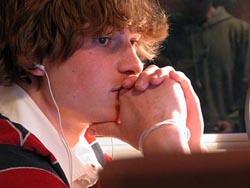 |
“In Power Nap Club, the music set the mood. We meet in a classroom – without music you might feel like you’re still in class but with music, it transports you out of the school setting. The music also covers the distraction of trying to sleep or meditate in a classroom with 20 other students; the Power Nap Club is my motivating force to not go home early and waste time.” - Catherine
|
“Power Nap Club has helped me to relax a lot. Sometimes it is hard to find a time where you can just relax and not worry about school work or other stressful things. Power Nap Club forces me to relax and I’m not distracted by other things – which is good because otherwise I probably wouldn’t make the effort. The music helps me to get into the relaxation state. If I were just to sit in my room in silence, I wouldn’t be able to concentrate or relax. |
Before I joined Power Nap, I used to take naps for a couple of hours, leaving me less time to work on homework and other important things. Also, since I slept for a few hours, it would be harder for me to fall asleep again and I would only get about five hours sleep, allowing the cycle to begin all over again. Now, after being in Power Nap for a year and a half, I come home and when I fall asleep for a nap, I always wake up about thirty minutes after, feeling completely refreshed.”
- Ellen
How do your peers deal with or respond to stress?
I find my peers deal with stress with methods similar to mine. Contrary to popular belief, I don’t find too many kids turning to substance abuse to deal with stress. I do see, however, stress interfereing with sleeping and eating habits. - Susan
Yes, definitely, drinking and smoking. (no name)
They often just plan ahead and make a list of priorities. There is a profuse amount of peer pressure in high school. - Eliza
|
I think most kids my age are really highstrung about school during the week. Most people are stressed about their work load during the week so when the weekend comes, people just want to let go of their stresses so they drink and smoke. – Laura |
Teenagers look for ways to “let out” their stress, at times it’s at parties or even in a fight; those are unhealthy. Others take it out on sports – always a good way. – Lara
|
IWe respond to stress by confronting it or ignoring it. This results in insomnia and a certain amount of insecurity. – George |
More Stress links:
• Stress: Who Has Time For It?
• Is Stress Getting to You?
• Can Stress Affect Your Health?
• Visit Read the Reviews for media articles about teen stress and the Power Nap Club.
• The Power Nap Kit includes a book, Teen Stress: An Inside View, which offers up-close expert and teen interviews, along with Power Nap Club how-to’s, stress coping strategies, and additional resources.
• Visit Stress First Aid for additional ideas and coping strategies.
“The number one block to good sleep is STRESS – it is the salient factor in most cases of insomnia. The levels of stress have gotten worse for teenagers today compared to say, 20 or 30 years ago. I think the concept of the Power Nap is excellent. Any time an individual begins to value sleep – which is enhanced by stress reduction – it will change their life.”
- Dr. James Maas, past chairman of the Dept. of Psychology, Cornell U., author, Power Sleep: The Revolutionary Program That Prepares Your Mind for Peak Performance
![]()
![]()
![]()

Teens ONLY is the place to visit if you’re interested in learning more about sleep, stress, your health, your behavior and why increasing your awareness and knowledge of these issues can make your life better.
This section of our website is currently under construction. Please check back soon to participate in and read about the initiatives listed below:
• Are you curious about how the health and behavior of U.S. teens compares to teens around the world? Read our summary of some recent research about U.S. teens and adolescents worldwide.
• Do you want to express your opinions or just sound off about what’s causing you stress? Take our Teen PULSE survey.
• Are you interested in what’s happening in research on sleep issues that relate to you and your health? Check back for articles about sleep experts conducted by students in our PNC Advisory Group.
![]()
![]()
![]()
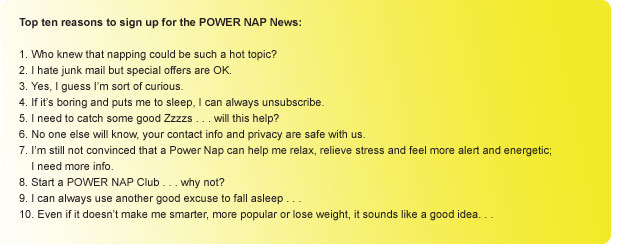
Sign up for Power Nap News!
Fill in the information below to receive email updates with news about sleep, power napping, the Power Nap Club™, Ask Anton and more.
*indicates required field
![]()
![]()
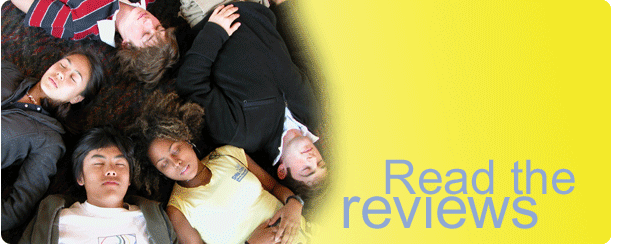
POWER NAP CLUB™
Media reviews and editorial coverage:
Since the POWER NAP Club™ was first featured in a local newspaper story in October 2002, it has attracted attention and been the subject of feature news stories worldwide including: wire services and newspapers, print consumer magazines, websites, radio and TV shows.
The following articles are excerpted versions of media coverage about the original, after-school Power Nap Club created by Anton Anderson. Media sources run the gamut from NPR Weekend Edition with Scott Simon to articles in Teen People, College Bound Magazine, YM, the Associated Press and The New York Post. If you’re giving thought to starting a Power Nap Club, or wondering how a power nap might help you, or just curious about why adolescence today is such a stressful experience, read on!
Click on any title below to go right to the feature or news story. Where possible, we have provided links to the articles or the publications that ran the original stories. Although we check these periodically to see if they are still “live links”, we have no control over content changes at these websites and we apologize if they don’t connect to the featured content.
![]()
- GHS Club offers rest for the weary
- Sleeping on the Job
- There's Something About a Nap
- Kindergarten Forever
- Power Nap Club
- Teens Snooze in Power Nap Club
- Weird BUT True
- Sleep for Success
- School News: The Scoop from your hallways and classrooms
- The Power Nap Club
- Sleepy Hollow
- 101 Cool Campus Activities
- Napping 101?
- Dream on...
- Talbot Speaker Talks About Sleep and the Consequences of Too Little of it
- Power Napping Refuels Weary Students
- GenStress: A Landscape of Pain
GREENWICH TIME
by Ivan H. Golden, Staff Writer
GHS Club offers rest for the weary
October 8, 2002
Greenwich High School has a club or sports team to satisfy almost any interest, from football to Middle East politics. Countless clubs encourage public service, while others, such as the Diversity Awareness Club, promote tolerance.
But only one club causes students to scratch their heads and ask, “Is this a joke?” and occasionally attracts students who just want to know if it’s real. The Power Napping and Meditation Society, founded several years ago, has become increasing popular recently, regularly drawing about 20 students to its meetings on Mondays.
The club is just what it sounds like: Students show up about 2:20 p.m., talk for a few minutes, then put their heads down on their desks and rest . . . Some fall asleep, others simply relax and listen. Around 3 p.m., the tape ends and the students get up and leave, most of them feeling refreshed.
Despite the seemingly silly nature of the club, its officers said the club accomplishes an important goal: It allows tired and over-scheduled students to get some rest. Many of the students in the club say they wake by 6 a.m. to get to school by 7:30 a.m. and often don’t get to sleep until after midnight.
“I know how tired I am at the end of the day,” said Anton Anderson, the Greenwich H.S. English teacher who founded the club. “And I can see how tired the kids are, too.” Anderson, who has worked at the high school since l969, started the club in part to fulfill a requirement: All teachers must spend at least 30 hours per year with students beyond the hours spent in class. But since he started it, Anderson said he has become convinced of its importance.
“Our students are under such stress, I didn’t want to start another club that insisted that they do good for others,” he said. “I wanted them to do something just for themselves. I honestly believe I’m doing the kids some good.”
Anderson credits the society’s co-presidents, Jenna Goldstein and Kelly Hannigan, both 17, with revitalizing the club. Before the two seniors took over last year, meetings drew only a few students, and sometimes no one showed up at all.
Many of the clubs members, like Goldstein, initially came on a lark but returned because it made them feel better. Goldstein, who plays varsity basketball and is a member of Signets, a community service club, said it is much easier to focus on sports and school work after she’s had a short nap.
“I get very tense when I play basketball,” she said. “And this really clears your mind. It’s important to know how to relax.”
![]()
The Hartford Courant
by John Jurgensen, Staff Writer
Sleeping On The Job
Instead of Getting You Fired, A Nap Could Fire You Up
October 26, 2002
Edison indulged. So did Napoleon, Kennedy and Clinton. And Churchill claimed they helped get him through the war. Naps aren’t just for the nursery school set, as these powerhouses of history prove.
Now a group of students at Greenwich High School also has learned the value of a strategic snooze. The Power Nap Club convenes on Monday afternoons after school dismisses at 2:15. About 20 students take a half-hour rest to recover from the classroom grind and rest up for the afternoon’s extracurricular activities.
Anton Anderson, an English teacher who has suffered his share of drowsy students during his 34 years at GHS, formed the club in l998. He envisioned a tonic for the demands of school, sports, social lives and college preparations.
“These students are being shuttled constantly from one place to another,” Anderson says. “The club is really hitting a need for these overstressed kids.”
Despite the anticipated appeal of sleeping on school property, the club was slow to take off. For the first few years, only one student attended faithfully. Then two of Anderson’s sophomore students, Jenna Goldstein and Kelly Hannigan, answered his appeal to try it out. They came prepared to crack up at the corny relaxation tapes and meditation exercises. But they got hooked and soon they were bringing their friends and boosting the club in the school bulletin.
Now they’re seniors, presidents of the club and proud that its membership includes “artsy kids and jocks, all kinds of people and all grades,” says Goldstein, a basketball player who finds the naps help her focus during afternoon games.
Hannigan, a swimmer who returned Monday from a recruiting weekend at Yale in time to nap, looks forward to the afternoon respite. She winces when she talks about the swim team’s 5:30 a.m. practices. “When I get out, I’m energized. But by first period of classes, I’m already drifting off.”
After the co-presidents run down the club’s agenda (new sweatshirts on the way, volunteers needed for the homecoming float) it’s lights out. Eyes closed, hands resting on his thighs, Anderson plays sandman. His silver Starbucks mug sits neglected on his desk before him as he guides the students in a meditation exercise.
“Imagine that your consciousness has been removed from the center of your mind. It becomes a ball of light,” he intones.
Light or no light, the students have probably been fighting this drugged feeling all day. As they finally surrender, chins meet chests, heads loll back and prone bodies arrange themselves on the floor. Within minutes, the sound of sleep of deep breathing drifts through the dark room.
Though sleep is a constant requirement for a healthy life, our demand for it fluctuates according to our age. Infants sleep about 16 hours a day in stretches of two to four hours. These sessions gradually consolidate, so that at age 1, most children are sleeping 12 to 14 hours a day, most of it through the night. By 10, children rely less on naps and sleep heavily for about 9 1/2 hours. But in adolescence, when the need for sleep increases to about 10 or more hours a night, the typical high schooler gets less than seven.
What’s more, adolescence coincides with a major shift in circadian rhythms, the biological cycles of a day. Teenaged bodies want to sleep late, but their schedules don’t allow it. The result:cranky, fatigued students.
Power naps are no substitute for healthy nighttime sleep habits. But a half-hour of quiet rest can do these teenagers good, says Anderson, and open their eyes to the demands of their bodies.
Napping has its place in the world of adults too. In recent years, some companies have seen the advantages of sleeping on the job. For example, Yarde Metals has makeshift nap rooms in all eight of its facilities, including the one being built in Southington. That’s just one of the amenities offered by this unusual company, which distributes part of its profits to employees. It also has gyms, coffee-roasting rooms and horseshoe pitches.
“We have some prominent nappers,” says Craig Yarde, who owns the metal processing and distribution company. “They’re on a certain clockwork. When they hit a low-end situation, they just take a little break and come back charging.”
In the classroom Anderson continues his quiet narration. Onepower napper’s snores rise above the meandering strings of the New Age music. Several students on their way to sports practice hoist their bulging backpacks, pick their way out and gently close the door. A few minutes later, the lights come up. Students rouse each other. They stretch, yawn and rub their eyes. “I can’t feel my legs,” says a new member. As she readies herself for her afternoon duties as a Red Cross volunteer, senior Catherine Jenks sums up her position as a power napper.
‘Teen-agers are not like adults in training. We’re still children, biologically.”
![]()
USA Today
November 6, 2002
“There’s Something About A Nap”
At Greenwich (CT) High School there is a new organization called the Power Nap Club. They have 20 members and they meet to nap. . .
“You have to be the best athletically, intellectually, wear the best clothing, go to the best schools,” according to Anton Anderson, an English teacher who started the club in l998. The Power Nap Club seems to help students gather their thoughts, gather a few winks and go off refreshed to be the best that they can be . . .
![]()
Independent Women’s Forum
November 8, 2002
“Kindergarten Forever”
A new club, founded by English Professor Anton Anderson, is gaining popularity at Greenwich High in Connecticut. Their motto: “Veni vidi dormivi – I came, I saw, I slept.”
The Power Nap Club devotes its weekly meetings to dozing off. Members are instructed on breathing and relaxation. “You’ve been holding your head up all day trying to pay attention in class,” Mr. Anderson said. “As you breathe out, let all tension flow away from your body.”
Seventeen year old Brian Mok has learned a valuable lesson since joining the club: “Quick, refreshing naps rather than long snoozes” will prevent embarrassing moments such as falling asleep in class. Even Thomas Murphy, a spokesman for the Connecticut Education Department finds that “naps have been very underrated in this world.”
Another expert agrees. Robert Fulghum, author of best-selling All I Really Need to Know I Learned in Kindergarten advocates, “Take a nap every afternoon!”
http://www.iwf.org/hotflash/021108.shtml
![]()
National Public Radio (NPR)
Weekend Edition with Scott Simon
Nov. 9, 2002
Power Nap Club
NPR’s Scott Simon speaks with Jenna Goldstein, co-president of Greenwich High School’s Power Nap Club, about why their stressful schedules have driven them to hone their sleeping skills at school. . .
Listen to this Weekend Edition audio interview at http://discover.npr.org/features/feature.jhtml?wfId=837564
![]()
Associated Press (AP)
by John Christoffersen
November 11, 2002
“Teens Snooze in power nap club”
GREENWICH, Connecticut
(AP) – Three boys are sprawled out on the classroom floor, their heads resting on their backpacks. Nap time in kindergarten? No, a meeting of the Power Nap Club at Greenwich High School in this wealthy community of high achievers.
The club was started by a teacher who figured that with all the pressure to succeed, some teenagers could use a little you-time.
Once considered a joke, the Power Nap Club has grown to about 20 members who meet on Mondays after school. The club even has T-shirts, a logo of a cardinal (the school mascot) wearing a nightcap, and a Latin motto: “Veni vidi dormivi — I came, I saw, I slept.”
At meetings of the Power Nap Club, members are encouraged to nod off in the classroom, and there’s no making fun of those who snore.
In Greenwich, one of America’s richest communities, with lots of lawyers, doctors and investment bankers, students are expected to get top scores on the SATs and apply early to Ivy League colleges. Extracurricular activities such as sports are a must to enhance the resume.
“You have to be the best athletically, intellectually, wear the best clothing, go to the best schools,” said Anton Anderson, a 58-year-old English teacher who started the club in 1998. “I think they buy into it. But it also means their lives are difficult and they need a little time for themselves.”
Thomas Murphy, spokesman for the Connecticut Education Department, said he is not aware of any other nap clubs in schools.
“But that doesn’t mean it is not an area to explore,” Murphy said, wistfully recalling nap time when he was a child. “As a 51-year-old male, I believe naps have been very underrated in this world.”
Forty winks and more
At 2,450-student Greenwich High, the Power Nap Club began to grow in popularity about two years ago when students Jenna Goldstein and Kelly Hannigan became enthusiastic supporters.
Club in session: Greenwich High student Katie Hanscom catches some shut-eye.
Goldstein and Hannigan, now seniors and co-presidents of the club, laughed at the idea at first. But they said they gradually came to appreciate the club, which also teaches relaxation techniques, for helping them manage their busy lives and focus better.
In Greenwich, “you have to do everything perfectly,” said Goldstein, who plays varsity basketball, works with two autistic children and has a job as a party planner.
Those expectations fade for a fleeting few moments on Mondays.
On a recent Monday, Anderson’s compact disc player was not working. He didn’t get stressed, though; he just loosened his tie and instructed the students on breathing and relaxing.
“You’ve been holding your head up all day trying to pay attention in class,” Anderson said, prompting a few boys to laugh. “As you breathe out, let all the tension flow away from your body.”
After about 20 minutes, Anderson gently awakened the students.
Brian Mok, 17, said the club has taught him to take quick, refreshing naps rather than long snoozes. That has helped him avoid such embarrassing incidents as the time his history teacher caught him sleeping in the back of the class.
“The teacher was like, ‘Everyone look at Brian in the back.’ I heard laughing and I woke up,” Mok said.
http://www.cnn.com/2002/EDUCATION/11/11/power.nap.club.ap/
http://www.cbsnews.com/stories/2002/11/05/health/main528283.shtml
http://www.wltx.com/healthwatch/health.asp?storyid=8357
http://www.examiner.com/headlines/default.jsp?story=n.naps.1105w
http://www.channelonenews.com/articles/2002/11/19/ap_naptime/
http://www.backwash.com/contentboard.php?con_id=35657
http://www.flboe.org/clips/clips/110502.asp
![]()
NEW YORK POST
November 6, 2002
Weird BUT true
Students don’t have to worry if they fall asleep in one Greenwich HS class. . . The Power Nap Club was started by a Connecticut teacher who thought his high-flying students needed a rest. It even has a Latin motto: Veni, vidi, dormivi – I came, I saw, I slept.”
Anton Anderson, who founded the after-school class, teaches techniques to manage kids’ lives better.
![]()
YM
(newsy page) by Sara Lyle
April 2003
“Sleep For Success”
When Jenna Goldstein first joined the Power Nap Club at Greenwich High School in Connecticut, she couldn’t take it seriously. “I had to leave early because I started laughing,” says Jenna, 17, now a senior and co-president of the club, founded in l998 to teach busy students how to relax. What was so funny” First of all, the after-school meetings begin with New Agey breathing exercises and visualizations. And the sound of kids snoring during the half-hour siesta can be pretty hilarious. But by her third meeting, Jenna was raving to friends about her refreshing naps. “They help me deal with the heavy load of stuff I have,” says Jenna. Could you use more z’s? Then go to ym.com to learn how to win a Power Nap Club kit, which includes two soothing CDs and a booklet of snoozing tips. The only bummer? The kit doesn’t come with the club’s coveted sweatshirt, which reads, “Veni, Vidi, Dormivi: I came, I saw, I slept.”
http://www.ym.com
![]()
Teen People
March 2003
f.y.i.
school news: The scoop from your hallways and classrooms
Students at Greenwich High School in Connecticut are resting easy thanks to seniors Jenna Goldstein and Kelly Hannigan, copresidents of the school’s Power Nap Club. The group – which meets every Monday afternoon in English teacher Anton Anderson’s classroom – gives stressed-out teenagers the time, space and permission to just conk out.
“Everything here is about getting into college,” explains Jenna, 17, who plays varsity basketball, volunteers with autistic children and, in her spare time, works for a party decorator. “You have to do SAT’s, SAT Iis and maintain a high GPA.” Power Nap, she says, is the only time frazzled students have for themselves.
Given that the average teen sleeps little more than seven hours a night – far less than the recommended nine—it’s no wonder that the club has hit a nerve: About 20 students regularly show up for the 40-minute snooze fest. Anderson begins meetings by dimming the lights, playing tranquil music and leading the group in a guided meditation. Then members are free to nap at their desks or on the floor, using their backpacks as pillows. “It’s my haven,” says junior Jack Davidson, 16. “It takes away my stress and gives me a boost to finish the day.”
Fellow sleepyheads, take heart. Power Nap may be coming to a school near you. The club has been featured in newspapers in places as far away as England, and Anderson has received dozens of e-mails from high school students around the country asking how to start one of their own. – Caroline Sorgen
![]()
The Review
University of Delaware
November 22, 2002/Vol.129/Number 21
By Anika Mamberg, Staff Reporter
The Power Nap Club
Once per week, teacher Anton Anderson walks into a Greenwich High School classroom in Greenwich, Conn., and talks about business in front of students, only to have them fall asleep before his eyes 10 minutes later. Most teachers would wake their students up or take their gesture as an insult. Anderson, however, takes it as a compliment. Beginning in l998 implemented the Nap Club, in which students learn breathing and relaxation techniques, accompanied by soothing sounds of meditation tapes. Anderson said he established the club because teachers need to spend 30 hours with students outside of the classroom.
“At the end of the teaching day, I’m so exhausted and a 20 minute power nap was what I needed to keep me going for the rest of the day,” he said, “so I tried to offer this to the kids.” He said when the club began, there were sessions when the classroom was empty. Soon after, two students, Jenna Goldstein and Kelly Hannagan, sparked interest among students and ever since then the club has grown.
Twenty regular members convene on Monday afternoons, and are seen wearing the words “Veni Vidi Dormivi” – I came, I saw, I slept – when walking down Greenwich High School corridors. The club currently sells candy bars to buy these sweatshirts, Anderson said.
“Looking at them, you can see that this particular club cuts across gender and demographical stereotypes that the group might have,” he said.
Greenwich High School senior Jenna Goldstein, co-president of the Nap Club, is also a member of the girls’ basketball team. She said the club is a benefit especially for those who are stressed out. Between homework and extracurricular activities, Goldstein said she barely has time for herself, and the club helps her relax. Sometimes before games, Goldstein attends the club or takes a power nap to ease her tension and calm her down. To get people involved, she said, she told friends to come to the room where they meet, without knowing why. She said they put fliers on their main bulletin board to advertise. Goldstein says the group’s fame is primarily because of local and national publicity from the media.
Anderson said it is interesting to see how the students act toward one another during the sessions. “The students treat each other with a lot of respect,” he said. “Instead of poking at each other to wake up they are very respectful and gently wake each other up. “When students need to interrupt the session and leave for some reason they do so without causing any interruption towards the rest of the group.” Goldstein said respect, however, is not the only benefit that comes from the group. “My friend who used to sleep in class all of the time does not do so as much because he attends the Power Nap Club” she said. Anderson said the Power Nap Club phenomenom is looking to branch out across the country. “I have a mother that just called me from New Jersey that would like to start the program in her area,” he said, “so obviously there is a need for this type of program.”
![]()
FAMILY CIRCLE
March 4, 2003
“Circle This”
What’s Up – What’s Hot – News to Use
by Margaret Jaworski
SLEEPY HOLLOW
“You snooze, you lose” definitely doesn’t apply to members of the Greenwich (Connecticut) High School Power Nap Club. The kids in this unusual club live by the motto Veni, Vidi, Dormivi – I came, I saw, I slept.” English teacher Anton Anderson started the club in l998 to teach teens techniques to help them “manage the pressures and demands placed on them by their parents, school and college requirements.” During the club’s weekly 30-minute sleep and learn meetings, Anderson, who has studied transcendental meditation and yoga, guides the students in relaxation and visualization techniques. “The key to making a nap work is to limit the snooze time,” he says.
“More than 20 minutes, and the body resists waking up.” Anderson hopes his methods will help the kids manage stress throughout their lives. The Power Nap Club Kit ($39.95) includes relaxing music and words of wisdom from the teens about managing stress. For more info:www.atpeacemedia.com
www.familycircle.com
![]()
College Bound Magazine
Spring 2003 issue
Cover story: 101 COOL CAMPUS ACTIVITIES
by Robin Tellefsen
#1 Get ready for the demands of college with the
POWER NAP CLUB at Greenwich High School, Greenwich, CT.
Their motto? “Veni vidi dormivi – I came, I saw, I slept!
www.CollegeBoundMag.com
![]()
Mary-Kate and Ashley.com
November 13, 2002
Napping 101?
Do you feel like dozing off in the middle of class? At one high school in Greenwich, Conn., mid-afternoon snooze sessions are so acceptable that they’ve even created a club for those in need of a nice nap!
Anton Anderson, a 58-year-old English teacher at Greenwich High School, started the “Power Nap Club” four years ago. The school is so competitive academically that, Mr. Anderson noted, many of his students are tired and in dire need of time to relax and regroup.
So every Monday, more than 20 sleep aficionados meet after school to crash, chill and catch some zzz’s. Kids camp out right on the classroom floor, using their backpacks as pillows. The club also teaches guided relaxation techniques to combat stress and maintain focus as kids prepare for college entrance exams and other life stressers.
We wonder: Do any of the Power Nappers snore?
http://www.marykateandashley.com/news/index.php?141
![]()
RAISING KIDS.co.uk
Parents’ News
November 7, 2002
Dream on...
Are your children stressed out by the relentless pressure of academic life? The Americans, first as always, have come up with an answer - the after-school sleeping club. Forget sport, TV, hanging out and other traditional teenage relaxation pursuits - pupils at Greenwich High School in Connecticut are meeting in a classroom after school to have a kip. The ‘Power Nap Club’ has its own Latin motto, ‘Veni, Vidi, Dormivi’ (I came, I saw, I slept) and 20 hardworking pupils now attend regularly for a restorative post-school doze.
Here at Raisingkids we propose that this is the best idea to come out of America since Mickey Mouse and should not only be adopted by all UK schools, but introduced for all hardworking parents!
http://www.raisingkids.co.uk/news/n11_0702.asp
![]()
Milton News
2003 Talbot Speaker Talks About Sleep and the Consequences of Too Little of It
April 2, 2003
On April 2, 2003, in the Fitzgibbons Convocation Center, Dr. Martin Moore-Ede, CEO and president of Circadian Technologies Inc., spoke to Milton students about sleep deprivation; his visit was part of the Samuel S. Talbot II ’65 Memorial Fund speaker series.
Recognized as an international authority on making lifestyle adjustments to help cope in our 24-hour society, Moore-Ede was among the first to define the challenges of living, working and sleeping in a our 24-hour-a-day, seven-day-a-week world.
“I’m here today to talk about the subject of sleep. How important is it, anyway?” said Moore-Ede. “One of the challenges in life is keeping alert. We’ve evolved from cave men and women who slept all night and remained active during the day to a society that never stops.”
Moore-Ede asked the audience of 700 students how many of them had slept 10 hours the previous night, or nine or eight. The majority of students responded that they had slept only five, six or seven. Moore-Ede noted that teenagers need at least eight and a half hours to function optimally. A major study of 14,000 11th graders in public schools, he said, found that students slept an average of just 7.1 hours. When Moore-Ede’s son Andrew ’98 conducted a survey of Milton students several years ago, day students reported sleeping 6.6 hours a night, while boarders reported sleeping only 5.9 hours a night.
“In general, if you find that you’re getting the same amount of sleep on the weekends as during the week, you’re probably getting enough sleep. If not, the difference is referred to as the sleep gap.”
Sleep deprivation, said Moore-Ede, affects your rate of error, can cause accidents, health problems and result in a shorter life span. “What fails first?” asked Moore-Ede. Creative problem-solving skills are the first attribute lost, he said, followed by impaired judgment (not knowing when it’s time to do one’s homework, for example), mood swings and low morale.
“If students become very tired, they become zombie-like. They can follow classmates from class to class—but they may wake up to find they’ve entered the wrong classroom,” Moore-Ede quipped.
In fact, national discussion continues about whether to alter the start times of schools to mirror more closely the natural sleep patterns of young people whose hormones dictate a preference for retiring–and waking—late. In the meantime, Moore-Ede recommends the value of napping to the masses.
At Greenwich High School in Connecticut, he said, students started the Power Nap Club. They adapted the Latin “Veni. Vidi. Vici.” (We came. We saw. We conquered.) to “Veni. Vidi. Dormivi.” (We came. We saw. We slept.), and emblazoned the declaration on club t-shirts.
“Instead of being lazy, napping is actually a productive thing to do. Napping is a very powerful tool,” he assured students.
“It’s all to do with timing. Sleep cycles are 90 minutes. If you catnap for 20-30 minutes, you’ll wake up feeling refreshed. If you wake after 40-50 minutes, you might feel groggy (because you’ve entered a deeper state of sleep but not yet finished the cycle),” Moore-Ede said. If a person can’t complete a full 90-minute cycle, it’s much more efficient to take a catnap, also called a power nap. In addition to getting enough shuteye, Moore-Ede recommends separating your sleeping space from your entertainment space and avoiding caffeine or other substances that chemically alter your level of wakefulness.
Moore-Ede also cited the importance of understanding when sleep deprivation can have tragic consequences. The Exxon Valdez and Three-Mile Island accidents occurred, for example, on the night shift while sleep-deprived personnel were in command. More automobile accidents are related to sleep deprivation than drunken driving.
Moore-Ede said that the army has also tested the value of napping when focus and stamina are required for long missions. In a test, two gunnery groups shot at targets for 72. The crew that went without any sleep actually hit fewer targets than the the crew that stopped every four hours to nap for 20-30 minutes: Productivity has less to do with the number of hours “worked” and more to do with the number of hours worked at a high level of alertness.
A Harvard Medical School professor, Moore-Ede led the team that discovered the biological clock in the human brain that controls the timing of sleep and wake, and pioneered the research on how the human body can safely adapt to working around the clock and sustain optimum physical and mental performance. In 1983 Martin founded Circadian Technologies Inc. (www.circadian.com), the leading consulting and publications firm dedicated to managing the 24/7 workforce. Circadian now advises over half of the Fortune 500 companies on 24/7 human capital management.
Moore-Ede has published over 125 scientific articles and 10 books related to his subject. His best–selling book, The Twenty-Four-Hour Society: Understanding Human Limits in a World That Never Stops, offers insights and advice to those seeking time-management solution that respect the body’s need to sleep. He is quoted in major national publications such as The New York Times and Newsweek and has appeared on talk shows including “Good Morning America” and “Oprah.” Moore-Ede is at work on a second volume, Competing 24/7: Investing Human Capital Around the Clock to Gain Strategic Advantage.
Moore-Ede graduated with a degree in physiology, earning first class honors (the British system’s highest ranking) from the University of London. He earned a medical degree from Guy’s Hospital Medical School and a doctorate in physiology from Harvard University.
http://www.milton.edu/news/pages/talbotspeaker4-03.asp
![]()
EDUCATION WORLD
The Educators’ Best Friend
by Ellen R. Delisio
June 03, 2003
Power Napping Refuels Weary Students
With school starting at 7:30 a.m., extracurricular activities stretching past 8 p.m., and jobs and volunteer work to squeeze in as well, sleep often falls to the bottom of the adolescent priority list. One Connecticut high school teacher, who decided his students needed some down time, formed an after school Power Napping Club to give teens 20 minutes a week to just sit back and relax. Included: Students talk about the benefits of power napping.
Over-packed schedules and 12-hour days are draining already sleep-deprived teenagers. In high schools where most students go on to college, the pressure to excel inside and outside of the classroom leaves students with little time to relax.
Anton Anderson, an English teacher at Greenwich (Connecticut) High School, decided to do something to help the waves of weary teens he was seeing every day. In 1998, he founded the Power Napping Club, which allows students to nap for about 20 minutes at the end of the day before going on to extracurricular activities. It’s motto: Veni, Vidi, Dormici (Latin for I came, I saw, I slept.)
“It is not a substitute for getting eight to ten hours of nightly sleep, but it does recharge the batteries,” Anderson told Education World. “It was clear to me — after 36 years as a teacher — that the children are oversubscribed. The pressures on kids are unprecedented in the history of adolescence. We are expecting them to function like executives of hot companies when they are 15 or 16. They have courses, athletics, community service, and jobs. I saw a lot of exhausted kids.”
During a Power Napping Club meeting in early May, six students gathered in a classroom to relax as soothing music played. Some laid down on the floor, others kicked off their shoes, or slumped down in their seats. “Napping club just gives me time to stop,” Tom, 17, a junior, said after his snooze. “People ask me why I don’t sleep at home. Here, we have a routine.”
Given their busy schedules, Tom and two other boys said a later school start than the current 7:30 a.m. would be a dream come true. “I’ve been waking up later and later since freshman year,” Brian, 18, a senior said. “I usually wake up at 6:30 a.m., or 5:40 a.m. if have band practice at 6:30 in the morning. I usually go to bed between 12:30 a.m. and 1 a.m.; I always have homework to finish late.”
“I think we should switch, and let the elementary kids start earlier,” Jack, 16, a junior said. “I teach third grade Sunday school, and the little kids are always up around 6 a.m. I’m in bed between 10 and 11, but don’t fall asleep until midnight.”
Tom added that he has the same problem, not falling asleep for an hour or two after going to bed. He still gets up at 6 a.m. most days, except during water polo season. Then he attends daily practices from 7:45 p.m.9:45 p.m., and three days a week is back at school at 6:15 a.m. for weight training. “It would be great if school started later,” he said.
Kelly, a senior club member, said she is not certain if starting school later would make a big difference. But she knows that on the days she gets up at 5:30 a.m. for swimming practice before school she is drowsy by second or third period. “I’m fine for about an hour after practice.”
Power Napping Club co-president Jenna, a senior, said while she is all for more sleep, she thinks delaying school’s starting time would just push back her drowsy spell to later in the day. “I usually get up at 6 a.m., unless I have homework to finish. Then I get up 4:45 a.m. or 5 a.m.,” Jenna said. “I go to bed about 11 p.m. Getting up is the hard part; it would be a lot nicer if school started later. But I’m involved in sports, and sometimes don’t get home until 8 p.m. now. If school started later, it would be hard to find time to do everything. And I’m just as tired in the afternoon as in the morning.”
Enter the appeal of power napping. “Obviously, it’s no substitute for sleep, but I definitely feel more relaxed afterward,” Jenna added.
http://www.education-world.com/a_admin/admin315.shtml
![]()
The Hartford Courant
GenStress: A Landscape of Pain
A four-part series on how expectations of perfection, the harsh judgement of peers and crumbling family bonds are hurting today’s kids. . .
By Andrew Julien, Hartford Courant Staff Writer
The Kids Are Hurting – December 15, 2002
Parents Turn Up The Heat – December 16, 2002
A Culture of Cruelty – December 17, 2002
What Happened To Dinner? – December 18, 2002
http://www.ctnow.com/news/specials/hc-genstress,0,3074649.storygallery?coll=hc-headlines-specials
![]()
![]()
![]()
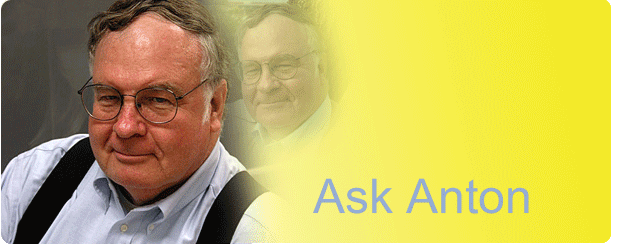
Do you have questions about starting your own Power Nap Club?
You’re not alone. English teacher and Power Nap expert Anton Anderson has fielded queries and questions from dozens of
people, interested in creating Power Nap Clubs™ in their schools and communities. The Power Nap Kit™ is just the beginning.
This is the place where Anton will provide answers to your questions about starting a Power Nap Club.
You can email any question you may have about Power Nap Clubs to anton@atpeacemedia.com. While we can’t promise that we’ll publish all of your questions, we’ll do our best and hope you’ll also feel free to share any other suggestions, ideas or comments.
Here are a few of the questions that Anton has received recently, along with his responses.
Hi Anton
My name is Grace Marie and I'm 13 years old, I recently read about your club in my health class and was wondering, what do you think about a powernap club at the Junior high level? Is there any difference? I have been back to school for a week and a half now, and every day I see groggy, tense teens racing to get to their next classes and met the deadlines that have already been set. My friend, Julia, and I went to present the idea to our head and vice principals this morning, and they laughed! We gave them some information from your site, and also some of the articles written about the club and they said they would think about it, but it didn't sound promising. What should I do if they say no, give up on the idea and wait until I am in High School?
Anyways, thanks for your time and I hope you can help me!
Grace Marie 13, New Hampshire
Dear Grace Marie,
Congratulations on taking the initiative to see the administrators in your school. What you are trying to do, establish an after-school Power Nap Club (PNC), is a very wise and needed idea, especially at the middle school/junior high level. At your age your body is using tremendous amounts of energy just trying to grow. On top of that, you are being bombarded with information all day – from teachers, parents, peers, coaches. This requires a lot of energy; it is no wonder that you and your friends are tired.
Don’t give up.
Tell your parents, your health teacher and even your family doctor about the research that has been done at colleges and universities such as Brown, Cornell and by the National Sleep Foundation that shows how important it is to get enough sleep – you’ll find a lot of this information in the book, Teen Stress: An Inside View, which is enclosed in the Power Nap Kit. While we don’t claim that a power nap will take the place of a proper night’s rest, research has shown that, done properly, it can give you a needed energy boost to help you with your day’s academic and athletic activities. You may also take some comfort in knowing that you’re not the only middle-schooler who is feeling sleep-deprived. Tell the adults in your life about the new study, recently completed by University of Massachusetts, Boston, psychology professor Jean Rhodes, PhD. Read an article about this new research titled, Sleep Shortage Takes Toll on Middle Schoolers at the UMass website.
Some day the adults in your world may even allow power napping to be done at specified times, during free periods, as part of your regular school day. For now all you can hope for is that they’ll let you start an after school PNC. The Power Nap Kit gives you all the tools to make this happen. Share the information in the Power Nap Kit with the people who have power in your life. The stories in the Teen Stress: An Inside View book within the Power Nap Kit are real testimonials from real kids.
Good luck, get plenty of sleep and
Start a PNC!
Hi Anton,
I’m in college and have practiced meditation for several years . . . what’s the difference between a power nap and meditation? Can I use what I know about meditating to learn how to power nap?
Tyler,
Illinois
Dear Tyler,
These are good questions. . . let me jump right in.
There are many kinds of meditation, but in general, meditation involves a practice of repetition, of sitting in silence, or actively concentrating on breathe, while focusing on the present not the past or the future. If you’re totally stressed out, it can be tough to ‘blank your mind’, which meditation generally requires. Also, if you’re in complete silence, you may find yourself going through mental checklists of everything you need to be doing.
I started to practice transcendental meditation when I too was in college. During meditation sessions, I often found myself trying to fight falling asleep and I didn’t get a good meditation session. . .
The advantage of a power nap is that you don’t have to feel guilty about falling asleep. Falling asleep is the goal. Yes, power napping is similar to meditation with its shared goal of focusing on the present and its use of breath awareness to aid relaxation. I find that peaceful music really helps the relaxation process during both meditation and power napping. Listening to a voice guided narration also makes it easier to not think about all of your worries, your responsibilities and all the things that make your mind race. . Since you already know how to meditate, you’ll find it easy to learn how to power nap.
Having trained in both methods, I find the power nap a more natural way of finding rejuvenation. That is not to say that a power nap is better than meditation – it’s just different. It’s easier to learn, it can be done in more settings, it requires no special postures and it can be done anywhere – in an office, in an empty classroom, while you’re waiting in an airport or a doctor’s office. If you’re really tired, take a power nap in the library before you tackle hours of homework. Sleep cycles are 90 minutes. If you take a power nap for 20-30 minutes, you’ll wake up feeling refreshed.
You’ll find good information about sleep research in the book enclosed within the Power Nap Kit which is titled, Teen Stress: An Inside View. It offers a lot of good information and fascinating research about teens, stress and sleep. Good luck and thanks for your interest!
Dear Mr. Anderson,
My name is Cassandra and I am a junior at a public school in Central Maryland. I read about your Power Nap Club in a news article recently and I was interested in starting a Power Nap Club at my school. Personally, as an honors student trying to maintain a 3.8 GPA while actively participating in school activities like National Honor Society and Leadership Institute, I’m just drained by the end of a typical school day.
I would like your permission to look into organizing a Power Nap Club at my school. If permission is granted, I would appreciate information on how to approach my school administration about forming the club and any other guidelines or rules of the club. Thank you.
Sincerely yours,
Cassandra
Dear Cassandra,
Thank you for your interest in the Power Nap Club concept. It sounds like you have a busy schedule and I can certainly see why you feel in need of an energy lift.
The single best way to find out about starting a Power Nap Club at your school is by purchasing the Power Nap Kit (PNK). We’ve devoted six pages of the book, Teen Stress: An Inside View (which is included in the PNK) to information about the Power Nap Club. There is an article about how and why I created the original after-school Power Nap Club (PNC) at Greenwich H.S., a “real person” interview with one of my PNC members who is now in college and a two page spread describing how to get a PNC started in your school or organization.
I think you will find this book very helpful. It contains articles describing the experiences of kids just like you, as well as documentation and ideas from psychology professors and sleep researchers from some of the best universities in the country. I can vouch for the authenticity of the kids’ experiences, since many of them were my former students. Make sure you read what Professor Maas’ student has to say as well as my student, Brian.
The Power Nap CD includes three of my own voice guided Power Nap narrations and the Power Study CD includes acoustic instrumental music to help you concentrate while studying.
Good luck and remember the 3 R’s of the Power Nap Club: Recharge, Refresh and Rejuvenate.
Hello Anton,
I read some website stories about your napping club in Greenwich, CT. I live in the UK where I don’t think I’ll have much luck convincing school officials that we could use a Power Nap Club, yet I’m often exhausted and think it’s a good idea. What do you think?
Clyde, 16
Manchester
Dear Clyde,
Unfortunately, teens and young adults in the USA do seem to suffer from a high level of stress and sleep deprivation; I see it every day in my high school English classroom. However, US adolescents are not the only ones who seem to be lacking the proper amount of sleep. In fact, a new, free publication titled U.S. Teens in Our World offers some interesting statistics about teens and young adults throughout the world. For example, in response to the question “In the past six months, how often have you had sleep difficulties?”, approximately 28% of U.S. 15-year-olds AND 35% of French 15-year-olds admitted to having sleep difficulties AT LEAST ONCE A WEEK. When asked, “How often do you feel tired when you go to school in the morning?”, the U.S. students actually ranked third among countries. However 40% of U.S. students claimed to feel tired four times a week or more, compared to a whopping 56% of students from Norway and 42% of students from Finland. While only 27% of students from England reported feeling tired, in answer to this same question, the fact remains that if you’re one of those sleep-deprived teens, and it sounds like you are, you still have a problem that deserves some attention.
Go ahead and make the effort to share your desire for a Power Nap Club with your school officials. You may want to refer them to an article published about my after-school Power Nap Club on the UK website, RaisingKids. I’m convinced the Power Nap Club is an idea worth pursuing outside the U.S.; I’ve fielded calls about my club from Austria, England, Canada and even Australia. You also might ask your school officials to visit Read the reviews here on the Power Nap Club web page.
Good luck in your efforts
Click here for additional question and answer with Anton.
![]()
![]()
![]()
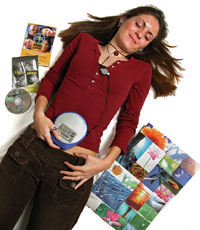 |
Welcome to the Power Nap Club Parent/Teacher Lounge! |
We’ve provided some resources below for your use. Anton Anderson has received many queries from teachers, educators and administrators about his after-school Power Nap Club. If you haven’t already, we invite you to visit the Power Nap Club™ media reviews to view editorial articles and feature stories about Anton Anderson’s Power Nap Club. We have also provided some press releases about Anton Anderson, his Power Nap Club and the Power Nap Kit below. Please feel free to contact jan@atpeacemedia.com if you have questions about any of the information on these documents or on this website.
A Letter from Anton Anderson
Anton Anderson Q and A
How Do The Teens In Your Life Handle Stress?
The Power Nap Kit Fact Sheet
Are you a parent or school administrator looking for fund-raising ideas for your school? At Peace Media offers volume discounts to educational organizations and sells Power Nap Kits directly to schools, PTAs, and PTOs.
Please contact sherry@atpeacemedia.com or call her at 800-619-1410 if you have any questions.
Looking for ways to enhance your healthcare curriculum for middle and high school age students? Please take a moment to peruse the suggested materials below. We continually update this information so check back for more.
Educator Study/Discussion Guides: The Power Nap Kit includes complete instructions, tips and suggestions for starting a Power Nap Club including the Power Nap CD that offers three power nap sessions written, narrated and recorded by Anton Anderson. The 44 page Teen Stress: An Inside View book enclosed in the PNK offers the expert views of medical, health and education professionals as well as interviews with real teens, all of which is designed to help young people understand the importance of relieving stress, taking power naps and in general taking charge of their lives. The Study/Discussion Guides (see below), created by At Peace Media and Anton Anderson, a high school English teacher, correspond to feature articles in the Teen Stress book. These are available FREE to PNK and PNC website visitors. Additional Study/Discussion Guides will be added as they become available. You'll find additional links to articles on the topic of teen stress along with comments from "real teens" in the Teen Stress section, here at the Power Nap Club website.
EV1: Generation Stress
EV2: The Mind-Body Connection
EV3: It’s the Way You’re Wired
EV4: The Sultan of Sleep
RP1: Stressed for Success
RP2: Coping in College
Looking for FREE resources for your Power Nap Club or healthcare curriculum?
The U.S. Dept of Health and Human Services offers a publication entitled, U.S. Teens in Our World: Understanding the Health of U.S. Youth in Comparison to Youth in Other Countries. This report compares health issues and behaviors of U.S. and foreign-born youth. You may not be surprised to hear that about 40 percent of U.S. students report feeling tired compared to fewer than 15 percent in some of the other ranked countries. Contributing factors cited include diet, exercise, school schedules, and other activities. Age, gender and other attributes are also discussed.
Click here for the short, 8 page, executive summary
Click here for the full-length 104 page report
Still looking for a reason to start a Power Nap Club in your school or community?
The National Institutes of Health (NIH) have identified adolescents and young adults (ages 12 to 25 years) as a population at high risk for sleep problems. Read this report published by The National Sleep Foundation's (NSF) Sleep And Teens Task Force about the sleep-related issues affecting adolescents. More >>
Sleep for research?
We are not kidding – if you live in southeastern CT, RI or southwestern MA, and you are between the ages of 9 and 25 years old, you have an opportunity to participate in important and innovative sleep research with a leading sleep lab in the US that has received funding from the National Institute on Alcohol Abuse and Alcoholism to study sleep patterns and biological rhythms.
More >>
Ask Anton: Do you have questions about starting a Power Nap Club™ in your school or organization? Ask Anton is a new, interactive forum for teachers, educators, parents and students who have questions about the power nap concept or the Power Nap Club (PNC). View current Q and As and email your own questions to Anton by clicking Ask Anton.
Power Nap News: Subscribe to a free, e-newsletter, the Power Nap News, which will debut this spring and is slated to be released quarterly. This newsletter, like our At Peace® Media e-newsletter, will offer suggested resources, highlight relevant news articles available online, and feature Q and A articles with healthcare and education professionals on topics to include power napping, stress relief and sleep issues. Visit the Power Nap/Sleep Info Center at the Power Nap Kit website for an extensive list of media articles that reference the importance of teaching teens and adolescence about the value of sleep.
Do you have a story about your own Power Nap Club you would like to share? Do you have content you would like to submit to the Power Nap News? Any suggestions on what you would like to read about in Power Nap News? Send all comments, story ideas, feedback and suggestions to jan@atpeacemedia.com.
Media Interviews/Appearances: Anton and other contributors to the Power Nap Kit are available for seminars and speaking engagements. For more information, please email Jan Liverance at: jan@atpeacemedia.com, or call 203-637-5424 (EST).
Thanks for visiting the Power Nap Club website.
![]()
![]()
![]()
 |
At Peace® Media |
![]()
Contact Us | Terms of Use - Privacy Policy | At Peace Media
© 2003 At Peace Media LLC. All rights reserved.